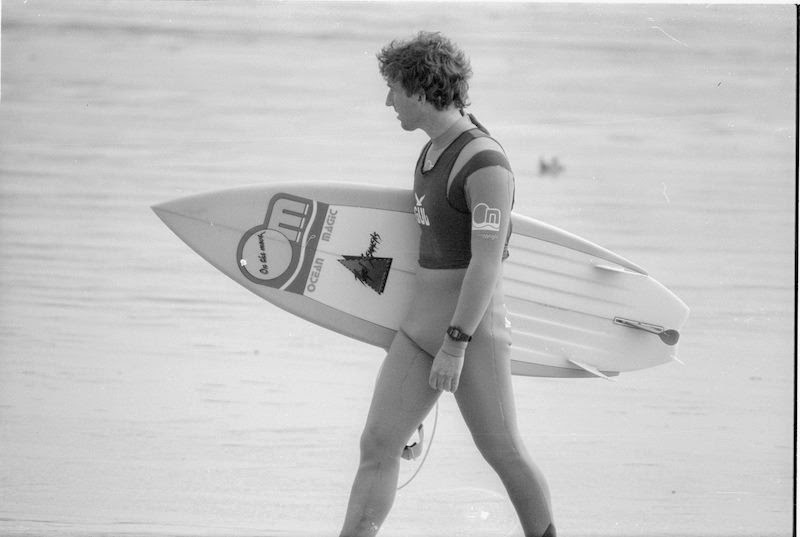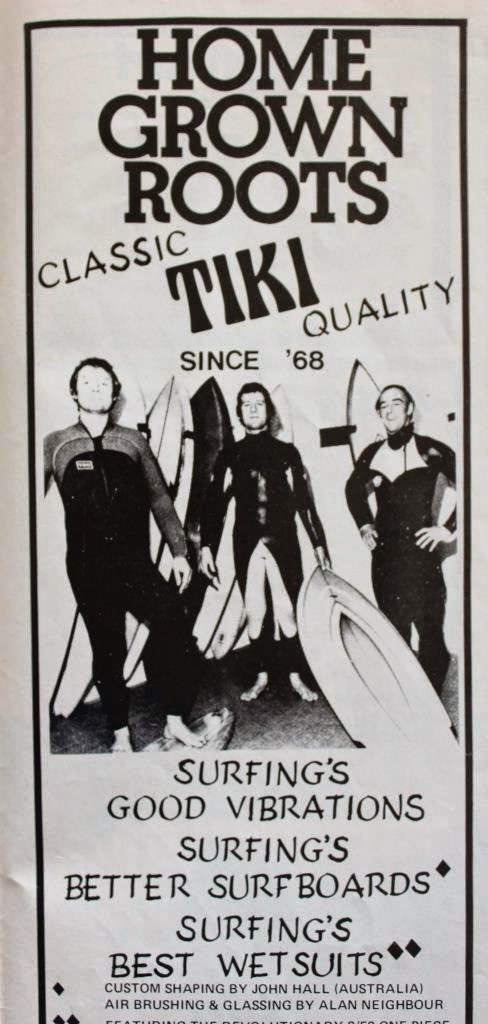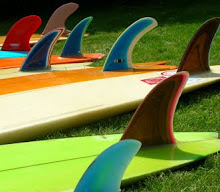This beautiful Newquay tourist poster was designed by Bruce Angrave in the 1930s . Made to advertise the delights of the Newquay coastline, it was commissioned by the Great Western Railway . What is most interesting is all the surfers bellyboarding , showing how popular surfing was back then . The beach is probably Towan , which was considered safe for surfing compared to the wild and dangerous Fistral.
The artwork is beautifully done with an airbrush, which was popular in posters back then. Needless to say this poster is now very rare and because of its subject matter sells for thousands of pounds !
Saturday, 31 January 2015
Friday, 30 January 2015
Carwyn Williams model by Nigel Semmens
This is Bill's 5'7 x 20 ,Carwyn Williams model 2 1/2 fin shaped by Nigel Semmens. These were the first Carwyn models produced , made before Carwyn moved over to shapes by Craig Hughes at Crab Island and then Wave Graffitti in the late 80s. These Semmens ones are very rare, and I havent seen another except my one. The Carwyn and Nigel (and Alder) partnership must have lasted a very short time, mine is no 2 , Bill's is no 9. Alder clothing was Carwyn's main sponser. I have not seen any old photos of Carwyn riding one of Nigel's boards either. The boards are short and wide 2 1/2 fins, no channels , excellent competition boards in mediocre British conditions.
These models probably aren't to be confused with Carwyn's personal riders, they were made based on his boards, but for sale to the public. Carwyn was already a big success in the early 80s with titles under his belt and photos in all the mags, so many young groms wanted to ride his boards.
Nigel Semmens with one of his boards from the same era, photo Alex Williams.
Carwyn with friend and classic Craig Hughes 2 1/2 fin, late summer 1983
and the same board in an Alder ad, winter 1983/84.
Newquay Surf Classic ,early 80s, Carwyn powers off the bottom of a decent fistral face .Sequence by Alex Williams
Another great Alex Williams shot , of Carwyn surfing at home in south Wales.
Ad from the Fosters Surfmasters comp. programme August 1984.
Learn to cutback with Carwyn -- from the Edge magazine June '86
5'8 board by Craig Hughes on the left, and my earlier 5'10 model by Nigel Semmens on the right , numbered NS Alder 2 .
Thanks to Bill and Alex Williams .
These models probably aren't to be confused with Carwyn's personal riders, they were made based on his boards, but for sale to the public. Carwyn was already a big success in the early 80s with titles under his belt and photos in all the mags, so many young groms wanted to ride his boards.
Nigel Semmens with one of his boards from the same era, photo Alex Williams.
Carwyn with friend and classic Craig Hughes 2 1/2 fin, late summer 1983
and the same board in an Alder ad, winter 1983/84.
Newquay Surf Classic ,early 80s, Carwyn powers off the bottom of a decent fistral face .Sequence by Alex Williams
Another great Alex Williams shot , of Carwyn surfing at home in south Wales.
Ad from the Fosters Surfmasters comp. programme August 1984.
Learn to cutback with Carwyn -- from the Edge magazine June '86
5'8 board by Craig Hughes on the left, and my earlier 5'10 model by Nigel Semmens on the right , numbered NS Alder 2 .
Thanks to Bill and Alex Williams .
Tuesday, 20 January 2015
Warwick bullet skateboard
These Warwick bullets were made in the UK in the late 60s, as an entry level board which undercut the more serious skateboards on the market . It also had a brake which helped the learner rider, but was not popular with experienced skaters.
In the mid 60s Bob Groves, and Bilbo had already imported real skateboards from the US - Hobies with laminated hardwood decks and proper cast metal trucks .Then Bilbo began to assemble them over here using US trucks and wheels , under the Hobie and Bilbo logos. These boards were only available in surf shops and were quite expensive.
The Warwicks were for sale in general sports shops across the country , and sold in their thousands. They had a plywood deck, inferior wheels and pressed metal sheet trucks. Many were also exported to Australia !
Finding a good condition Warwick now is hard but not impossible ; the Hobies and Bilbos are gold dust.
Thanks to Tony for some of this info.
Riding a Warwick, British Surfer no.1 mag, 1969.
Below- surfer and skater dude Prince Charles in the early 70s. He was a keen surfer while at uni in Wales and as he says of skateboards - ''I have got one of me own you know '' and ''If I'd known there were skateboards here I'd have brought my protective paraphernalia '' ! A classic piece of film.
Thursday, 15 January 2015
Zuma Jay kneeboard
I bought this board from the dump, covered in layers of spray paint. After some sanding back I found out it was a Zuma Jay from Bude . Its a twin fin kneeboard or kids board , 5'2 long with multi fins and channels. In good condition under the paint, its got a great logo which looks more 70s than early 80s when the board was made. It would have been pretty bright when it was made !
Zuma Jay was one of Bude's main surf shops. The main Zuma Jay company was in California, and the Bude one was an offshoot of that with boards shaped locally under licence.
A good shot of a day glo Zuma Jay . The girls look a bit more California than Bude.
Zuma Jay channel bottom on ebay.
Early 80s ad
Thanks to Kirsten and DJ for the photos.
Zuma Jay was one of Bude's main surf shops. The main Zuma Jay company was in California, and the Bude one was an offshoot of that with boards shaped locally under licence.
A good shot of a day glo Zuma Jay . The girls look a bit more California than Bude.
Early 80s ad
Thanks to Kirsten and DJ for the photos.
Tuesday, 13 January 2015
Tiki mini gun with 70s wax
I picked this board up late last year. It had been in a garage in Cheshire for over 20-30 years , luckily only 15 miles away from where my Dad lives so I asked him to get it for me. It looks little used since the late 70s and still has the original coat of wax, which is a lot harder than modern wax and a bit like candle wax. It was made around 1975-76 and is 7'3 x 19 1/2, a gunny shape possibly by John Hall. Under the wax (which I will leave on for prosterity) the deck is near perfect . I love the warm grey tint, one of my favourite colours for boards, and the red pinline sets it off well. The board is very flat on the deck, with little volume at the tail. Designed to be ridden Terry Fitzgerald style - on good waves .
Tiki ad 1977
Tiki ad 1977
Surfboard Wax in the 60s by Tony Cope
Wax is
rubbed onto the deck of a surfboard to
build up a sticky layer to prevent the
rider slipping off when the surface is wet.
The only
available wax in the early 1960`s was a block of solid paraffin wax, purchased
from a local chemist . A typical 1 lb block
( about 450 gm ) cost 1/6d
............. today, about 8p.
You needed a
block each of Hard and Soft wax and a
pan full of boiling water, to treat the
deck of a new board.You dipped
the end of the Hard wax (melting point 70
degree C, meant for candles) into the
hot water to soften it, then rubbed the bar hard across the surfboard deck
until blobs built up on it.
The much
stickier Soft wax (45 degree C, meant
for skin-care products) was rubbed straight
onto the previous coating , making a
good adhesive surface.
On really hot
days the Soft wax could melt, leaving only the base of Hard wax below to prevent
the rider slipping off a wet surfboard.
Today`s
surfboard waxes are a mixture of candle wax, bee`s wax , colouring and scents
(!) , and handle a wide range of temperatures.
And they don`t need softening in hot water.
A big
improvement .
An original block of Waxmate from the mid 70s ? , distributed by Tiki. It still smells nice !
1979 ad showing the waxes Tiki distributed. 10 p per bar !
and one from 1973.
Thanks to Tony for the info on 60s wax . It sounds a right hassle in those days , and surf wax without the smell just doesnt seem right.
An original block of Waxmate from the mid 70s ? , distributed by Tiki. It still smells nice !
1979 ad showing the waxes Tiki distributed. 10 p per bar !
and one from 1973.
Thanks to Tony for the info on 60s wax . It sounds a right hassle in those days , and surf wax without the smell just doesnt seem right.
Subscribe to:
Posts (Atom)























.jpg)



































